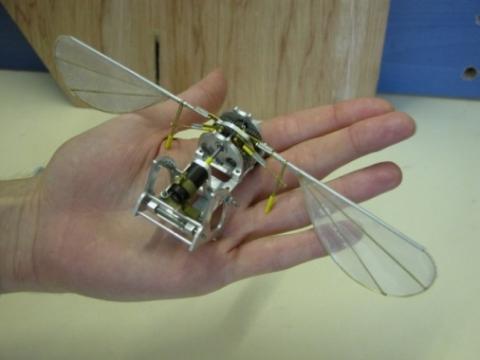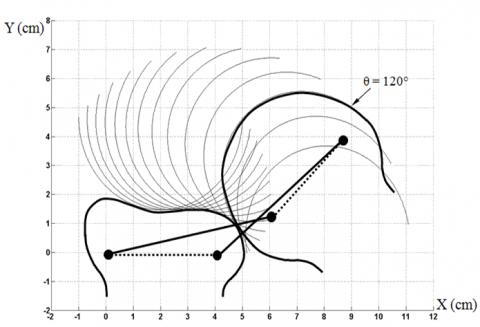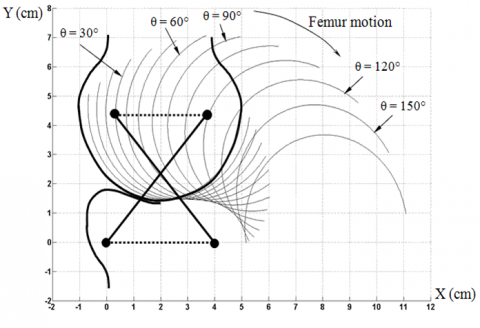Great Information Found in Inspiration from Creation
By
Inspiration from Creation 1 was written by Stuart Burgess and his friend Dominic Statham to show us what an awesome Creator we have by citing just a few of the great things that have been invented by studying His marvelous creation. Six chapters in the book were written by Burgess, and Statham wrote the other three. Burgess has held academic posts at Bristol University and Cambridge University in the United Kingdom and at Liberty University in the United States. Most of all the highlights below came from the chapters penned by Burgess. This book inspired me to spend a lot more time looking for other things that have been developed by trying to copy what our Creator has done.
Burgess was appointed Head of the Department of Mechanical Engineering at Bristol University three times between 2004 and 2011. He has worked for the European Space Agency and was the lead designer for the solar array on the world’s largest civilian earth-observation spacecraft (Envisat). This project cost 1.6 billion dollars, and if his part of the project had failed, all that money would have been spent in vain because the panel would not be deployed and there would be no energy source to power the craft.
Burgess also led the design and testing of a high tech chain drive for the British Olympic Cycling Team who won a record six gold medals at the 2016 Rio Olympics, which is also no small feat. And he has published over 160 scientific papers on the science of design in engineering and nature and has seven patents too.
Burgess has written several books on apologetics including one titled Hallmarks of Design and has given talks on the Design Argument at many institutions around the world, including in the United States, Canada, El Salvador, Australia, South Africa, Singapore, Japan, and many European countries.
Burgess says engineers need lots of inspiration because coming up with new designs that no one else has ever thought about before is extremely difficult work. How about you? Have you ever designed something that has never been built before? I’ve only had one decent idea during my 68 years on this planet that sounded like it might actually keep the deer out of my garden. When I contacted a company that could build this item, they said they were already working on it.
Before drones were popular, the British military hired Burgess’s design group to develop a device that was small enough to fit in the palm of your hand and yet quiet enough to remain undetected when it flew into a window to spy on their enemies. The designers accomplished this task by filming a dragon fly in action and then slowing down the film enough to allow them to see how the insect can maneuver so well without making any noise...and they copied God’s design as much as they could.
They discovered that the bug’s wings not only move back and forth like a hummingbird’s wings, but they also rotate at just the right time to make it hover even better than a helicopter can. They designed a four-bar mechanism that has a flap angle of 80° and also twists 40° at the precise time in the cycle (Fig. 1).
Burgess says that a dragonfly basically begins life as a submarine-type creature and morphs into a helicopter-type creature without any mechanics around to help! And the four-bar mechanism used to help him fly could not have evolved through a step by step process because the four bars and the four joints all need to be in place simultaneously or it does not function at all.
Engineers use sophisticated four-bar mechanisms in car suspension and steering systems. Four bar mechanisms are so complex that only fully qualified engineers (and God) have the required skills to design them. The knee joint also has one of these mechanisms per his design team (Fig. 2).
Burgess learned that it is impossible to produce a micro air vehicle with the same performance as that of a dragonfly. The machine his team built weighed ten times as much as the dragonfly that they had copied, the wings flapped a quarter of the dragonfly’s speed, and the batteries lasted only a few minutes. Dragon flies are not primitive creatures but are marvels of design and provide powerful evidence for Biblical creation.
The natural world is exceptionally well designed, and most of the world’s top designers freely admit that they are in awe of nature’s solutions. This presents a problem for Darwinists because optimal design is not usually achieved by taking an existing device and making a series of tiny changes. Radically new concepts are required. For example, piston engines in airplanes were replaced by jet engines, which have a much higher power-to-weight ratio. And telephone cables were replaced by microwaves. And vacuum tubes were replaced by transistors. And we find no transitional forms between the items that were just mentioned.
Engineers invent new things by brainstorming. They are not shackled by just tweaking what they already have. The Darwinian process cannot do this. Once it has adopted a particular concept, it is stuck with it. The process cannot look ahead and see what kind of system it will need to evolve into in the future. If evolution were really true, all we would see around us would be limited to the evolutionary process, where animals are just a little different from the animal that they evolved from. For example, which animal did a porcupine evolve from?
Burgess cites Romans 1:20 as one of the key verses for his book. It says, “For since the creation of the world God’s invisible qualities—His eternal power and divine nature—have been clearly seen, being understood from what has been made, so that people are without excuse.”
Richard Dawkins, one of the most famous atheists on the planet, says this is not really true. He claims that we see evidence of chaos all around us and it appears that nothing was designed. Stuart Burgess says Dawkins is not really an expert on design because he has never designed anything...not even a doorknob.
After working on the dragon fly device, Burgess’s team decided to try to improve man-made knee joints by studying the knee joints that God created. The early man-made joints were basically ball and socket items that limit movement. The joint that Burgess team made mimics what a real human knee does.
Engineers have studied shark skin and have now made a material that can be used to stop algae from growing. They have made a swimsuit that worked so well that it was outlawed in swim meets because contestants who wore it were winning all the races!
When engineers studied bombardier beetles, they used a similar concept to make fuel injection systems for cars that worked so much better than carburetors.
Someone studied the burdock plant in order to design a better zipper system, and we now call this invention “Velcro.”
Engineers almost always take a top-down approach when designing new systems such as providing heat for a new building. The first step would be defining the overall layout, followed by selecting the subsystems, selecting the individual machines, and finally designing the individual components such as blowers, ductwork, dampers, etc. This top-down approach ensures that each subsystem is designed in a way that takes into account the needs of all the other subsystems. Engineers are taught not to design bottom-up, where we start with individual components, because it is impossible to foresee the requirements of other potential subsystems. The design methodology used by engineers emphasizes why the human circulatory system could never evolve because the theory of evolution involves bottom-up developments. For example, we could easily bleed out without a clotting system in place, yet our clotting system causes lots of issues when it provides clots at the wrong time. So we really need both the items that plug the holes and the control unit at the same time. In evolution we get the controller at some random point in time and we get the “pluggers” at some other random point in time when things develop bottom-up.
Engineers would love to be able to duplicate what the human heart, eyes, and ears do. We’ve been able to build something like a heart, but it does not last nearly as long, and it damages the blood so much when it pumps that recipients must take clot preventing medicine.
I’ve been working with pumps and piping systems for over 40 years now. I have always seen engineers provide one pump for low pressure systems and another pump for high pressure systems. God’s pump does both in one! The low-pressure side of the heart sends blood to the lungs, where the flow needs to be slower so that it has time to absorb oxygen. The high-pressure side sends flow to the 100 trillion cells that need nutrients, waste removal, pH adjustment, water delivery, infection defense, and temperature regulation. Blood needs to pass within 0.1 mm of each one of these cells to do these tasks. Guess how long these blood vessels, capillaries, etc. would be if we placed them end to end? Believe it or not, several sources state that the length would be about 62,000 miles—the circumference of the earth is only 25,000 miles! And the blood circulates through this complex system about 1500 times each and every day!
The best heart pump that engineers have produced thus far lasts about four years, yet so many of us have a pump that lasts for over 70 years with zero problems! And our pump increases in muscle mass for people who need larger hearts to compete in sports and then returns to normal when the 40% increase is no longer required. This larger heart can pump enough blood to completely fill a bathtub in only three minutes by increasing beats per minute almost three times in some cases... so that every cell has enough oxygen, nutrients, etc. This is what enables us to play a game of basketball, climb a mountain, etc. And blood flow to the gut, liver, kidney, spleen, and inactive muscles is decreased when the rest of the body needs additional flow during exercise—wow again!
One would think that our blood pressure would drop so low after traveling through 500 capillaries per cubic inch that it would have trouble overcoming gravity on the way back from the feet to the heart, but our Designer also took this into account and added check valves in the return lines back to the heart! Please note He also added valves called “sphincters” that close during cold weather to reduce flow to the hands and feet that would place undue stress on the heart while it is keeping everything warm.
Evolution says fish had a two-chambered heart that evolved to a three-chambered heart in amphibians that evolved into a four-chambered heart in mammals. But they fail to talk about all the internal channels and external plumbing that must evolve at exactly the same time as the chambers or else the animal dies. And having two circuits in the heart with only one circuit outside the heart (or vice versa) also fails.
Blood is amazing as well. Platelets change shape and stick together to plug holes. White blood cell flow is increased at just the right time and in just the right quantity. This task is accomplished by a hormonal system that sends chemical signals to the brain and the nervous system, and they, in turn, control what gets sent where and when.
Red blood cell production is controlled by a hormone that is produced by the kidneys. These cells are created in the bone marrow and released when they are mature. White blood cells are created in the bone marrow, spleen, and lymph nodes.
Various sensors in the body collect data and send it to the brain that processes it much like a computer does. The data is transmitted to the nerves that act as communication cables to various actuators that regulate the heart and the hormone production system.
Modern car engines have copied a lot of this design in that the car’s oxygen sensor measures how much oxygen, unused fuel, etc. is showing up in the exhaust stream and tells the actuators to provide more or less oxygen and fuel to optimize the mixture for various driving conditions. This system has irreducible complexity in that it no longer functions when the oxygen sensor, the wiring, the actuators, etc. malfunction, so it’s usually all or nothing. It’s very hard to believe that all of the same types of systems in the human body evolved step by step when some of the parts had not even evolved yet.
And the same type of thing is true when new “parts” are made inside of our bodies. My wife and I visited a Toyota manufacturing facility near Lexington, Kentucky several years ago where 10,000 people produced a new vehicle every 57 seconds, all day, every day. Lots of designers had to make each and every part which had to be both extremely accurate and easy to install, plus they had to minimize risks so that any failure would not cause 10,000 workers to stop working until it was fixed. So every tiny modification had to be tweaked to avoid bottlenecks and misfits further down the line.
We have 100 trillion cells in our bodies, and each cell has an assembly line where tiny machines do their jobs flawlessly every single day; so they, too, had a Designer. “Chaperonins” fold proteins into the right shape after assembly by the ribosome, and these chaperonins reject any part that does not conform to the specifications. So mutations, mistakes, etc. do not result in evolutionary change because they are rejected like the cars on the assembly line were rejected when they did not meet the specifications.
And some of the things that look problematic when we first discover them actually provide some benefits that we really need. We cringe when a doctor tells us that we have a virus, yet some viruses help plants tolerate more heat and drought while other viruses destroy cancer cells, keep soil fertile, act as a secondary immune system, and prevent bacteria from entering our gut lining where they would produce a deadly infection.
Our skin can also become a problem. Sometimes we wish that our skin was not so sensitive, especially when we are spending a day at the beach. But just think about all the good design we see in our “earth suits” when we examine them in detail. Where would we be if our covering were not filled with millions of tiny sensors that protect us from things that would utterly destroy us without this detection system. These marvels are sensitive enough to let us know when a fly is walking on us yet not completely overwhelm us when a 300-pound football player lands on us. Man has never built anything that came anywhere close to this 10,000,000-to-1 variance. Our feet tell us when there’s sand on our floors yet can endure lots of pounding when we run a marathon. And the same sensor that feels the ant crawling on us does not keep telling us that a shirt is touching our skin over and over again.
Our Designer sets things up so we get a new earth suit often in that new skin cells are being added every day. Engineers keep trying to make something that functions like skin when they make robots. Artificial skin always has wrinkles when there are lots of oddball shapes not very far apart. And man-made skin does not stretch and return back to normal again like the skin that was fearfully and wonderfully made (Psalms 139).
Engineers also have trouble duplicating all the sensors, actuators, piping, wires, connections, etc. that exist in something that is as thin as our skin is. Our skin helps cool us down, heat us up, provide sweat when we really need it, keep dangerous liquids outside of our bodies, etc.
The skin on our feet is designed to become thicker when we have no shoes, which is a very nice feature for some of the natives in Africa that have never owned a pair of shoes. And our bodies increase melanin production when we need to work out in the sun a lot more often, to help protect us from the sun’s rays.
Engineers are also trying to copy the skin’s ability to heal itself. Where would we be if we had to run to a hospital each and every time we cut ourselves a little bit? Our bodies speed up cell division in the area to fill the gap where we are cut and then returns to normal when this function is no longer required.
Robots can perform some surgeries better than man can, but the robots cannot feel an organ and tell us that the organ is OK like it is or that it needs attention. Robots can harvest tomatoes, but only if the tomato’s genes have been modified so that the tomato has a thicker skin that will not be damaged by the robot.
Burgess ends his book by stating on page 129 that Jesus is the designer. And then he says that we’ll get a new life that is pleasing to God if we repent and turn to Jesus. Those who do this will no longer suffer and die after Jesus returns to restore the world to its original, perfect form. What a great way to end a book!
- 1Burgess S, Stratham D (2017) Inspiration From Creation, Creation Ministries International, Eight Mile Plains, QLD



